In Rin Nadeshico's computer graphic illustrations, Mt. Fuji looms in the distance as high school girls lounge around with various oversized creatures.



Lots more at Rin Nadeshico's website.
In Rin Nadeshico's computer graphic illustrations, Mt. Fuji looms in the distance as high school girls lounge around with various oversized creatures.



Lots more at Rin Nadeshico's website.
Joge-e, or "two-way pictures," are a type of woodblock print that can be viewed either rightside-up or upside-down. Large numbers of these playful prints were produced for mass consumption in the 19th century, and they commonly featured bizarre faces of deities, monsters or historical figures (including some from China). Only a few examples of original joge-e survive today. Here are a few.

This print by Kuniyoshi (c. 1852) depicts Hotei (Laughing Buddha) and Shoki (a character from the "Romance of the Three Kingdoms"). When viewed upside-down, Hotei becomes Asahina (a character from a popular novel of the time) and Shoki becomes Zhang Fei.


This woodblock print was published by Ezakiya Tatsuzo (c. 1842). Left to right, top to bottom (upside-down image described in parentheses): 1. Small tengu (Gedo, an evil person), 2. King Zhou, Shang Dynasty (Guan Yu), 3. Wind god (Thunder), 4. Nyudo (Pair of frogs), 5. Tengu looking up (Tengu looking down), 6. Tofu Kozo (Mitsume Kozo), 7. Onamuchi-no-mikoto, Shinto god of nation-building, farming, business and medicine (Iruka-no-omi), 8. Cao Cao (Shoki, Zhang Fei), 9. Mikenja (Ghost of Mirin).


This print by Kuniyoshi (c. 1852) shows a Daruma and Tokusakari (a character from a famous Noh play). Viewed upside-down, the Daruma becomes a Gedo (an evil person) and Tokusakari becomes Ikyu (a character from the famous play "Sukeroku").


Created by Yoshitora, 1861. Left column (top to bottom): 1. Fukusuke, god of merchant prosperity (Frog), 2. Evil man (Ebisu, god of fishermen and good luck), 3. Fukurokuju, god of wisdom and longevity (Tanuki, racoon dog with giant scrotum). Center: 4. Ikyu (Foreigner) , 5. Okame (Dekusuke), 6. Gedo, an evil person (Asahina). Right: 7. Hotei, Laughing Buddha (Yakko), 8. Earth god (Mountain god).


Created by Yoshitora, 1862. Left column (top to bottom): 1. Tadafumi (Gedo, an evil person), 2. Hunter (Frog), 3. Small tengu (Big tengu), 4. Bad guy (Bad guy). Center: 5. Two-horned demon (One-horned demon), 6. Kasane, possessed female character in famous Kabuki play (Ugly man), 7. Daruma (Daruma). Right: 8. Foreigner (Ainu), 9. Nio guardian (A-un guardian).

[Images from: Edo no Asobi-e, Tokyo Shoseki, 1988 (out of print)]
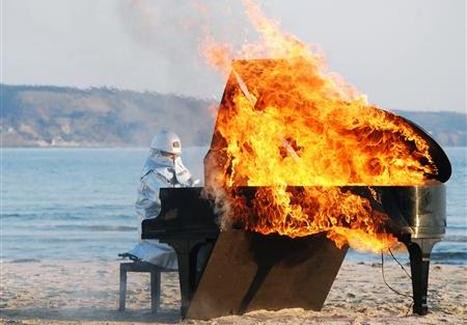
On March 8, pianist Yosuke Yamashita donned a fireproof suit and played a burning piano on a beach in Ishikawa prefecture. The improvised jazz performance went for about 10 minutes until the flames rendered the piano silent. This video shows a few excerpts.
Yamashita's performance was a reenactment of a similar one he gave in 1973, which was made into a short film by Japanese director Kiyoshi Awazu. You can see the complete 1973 performance on Awazu's website.
[Source: Sankei]

The music video for Ken Ishii's "Space Invaders 2003" is a touching, behind-the-scenes look at a Space Invader family torn apart by war.
Long ago in Japan, human illness was commonly believed to be the work of tiny malevolent creatures inside the body. Harikikigaki, a book of medical knowledge written in 1568 by a now-unknown resident of Osaka, introduces 63 of these creepy-crawlies and describes how to fight them with acupuncture and herbal remedies. The Kyushu National Museum, which owns the original copy of Harikikgaki, claims the book played an important role in spreading traditional Chinese medicine in Japan. Here are a few of the beasties found in the book.
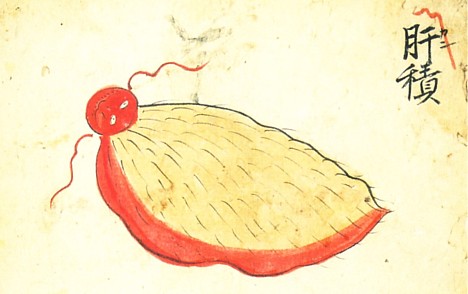
Kanshaku
Kanshaku, an angry-faced bug found in the liver, aggravates its host by violently thrusting itself upward toward the chest cavity. Infected people tend to shout with rage or engage in activities to blow off steam, and they crave acidic food and avoid eating oily food. Acupuncture can stop Kanshaku.
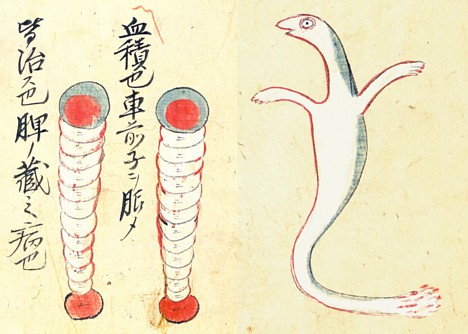
Hizo-no-kesshaku, Kanmushi
Hizo-no-kesshaku causes problems with the spleen, but it can be cured by ingesting shazenji (plantago seed).
Kanmushi is a harmful parasite that embeds itself in the spine, causing it to curve backward. Infected people also develop an appetite for spicy food. The herbs mokko (Saussureae radix) and byakujutsu (Atractylodes macrocephala Koidz) are effective in fighting off Kanmushi.
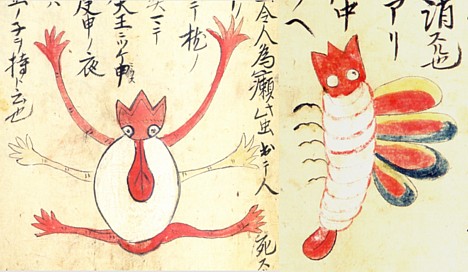
Gyochu, Haimushi
Gyochu, a deadly critter responsible for leprosy, acts as a messenger to the underworld. On the night of Koshin-no-hi (an important date occurring every 60 days on the Chinese calendar), Gyochu leaves the body to visit Enma-daio (Lord of the Underworld) and tell him of your misdeeds. Enma-daio is known to punish people for bad behavior by reducing their remaining time on earth.
Haimushi, a creature with an appetite for rice, causes problems with the lungs. If the Haimushi exits the lungs and cannot find its way back, it turns into a fiery will-o'-wisp (hitodama) and the person dies. The herb byakujutsu is effective in warding off Haimushi.
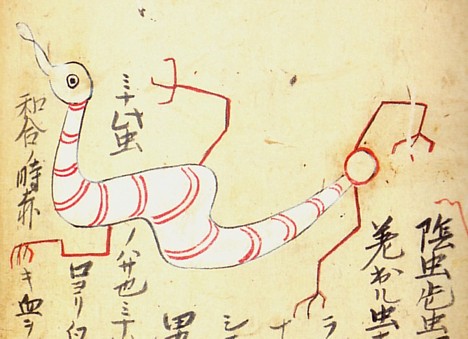
Kagemushi
Male and female versions of the Kagemushi appear during sexual intercourse. When the two bugs come together, their wiry legs get tangled up, the female bug spits up red fluid, and the male spits up white.
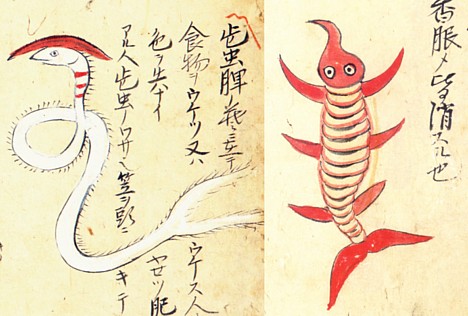
Hizo-no-kasamushi, Akuchu
Hizo-no-kasamushi, a worm found in the spleen, causes its host to gain or lose weight based on the amount of food it eats. The herbs agi (giant fennel) and gajutsu (purple turmeric) are effective in controlling Hizo-no-kasamushi.
Akuchu, also found in the spleen, consumes rice eaten by the host. Drinking mokko is an effective antidote.
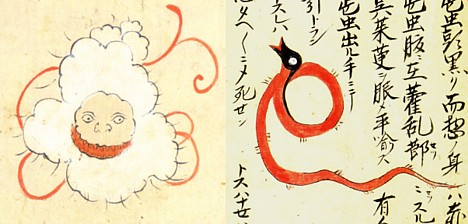
Haishaku, Kakuran-no-mushi
Haishaku, a critter found in the upper lungs, has a nose that opens directly into its chest. People infected with Haishaku hate pleasant smells and foul smells, but are fond of strong, fishy smells. Other symptoms include extreme sadness and a craving for spicy food. Gentle, shallow acupuncture is an effective treatment.
Kakuran-no-mushi, a worm with a black head and red body, invades the stomach and causes vomiting and diarrhea. It is known to come up into the host's mouth and poke its head out. Try to grab it, and you choke for air, but let go and it returns peacefully to the stomach. The herbs goshuyu (Euodia rutaecarpa), shazenshi and mokko are useful in fighting Kakuran-no-mushi.
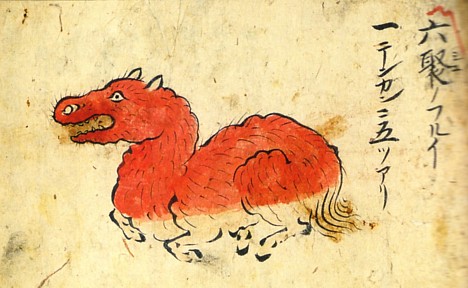
Umakan
Umakan, a beastie that causes heart problems, infects people outdoors in the scorching sun or in the vicinity of fire. Acupuncture is an effective treatment.
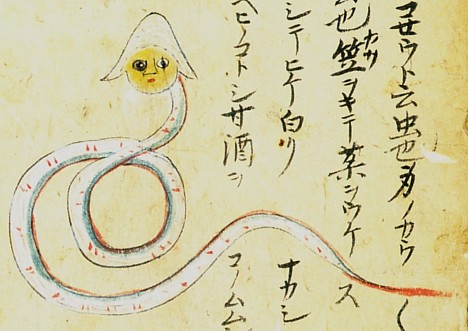
Koseu
Koseu (Kosho), a snake-like critter with a scruffy white beard, wears a hat that protects it from medicine. It likes to drink sweet sake and it can speak.
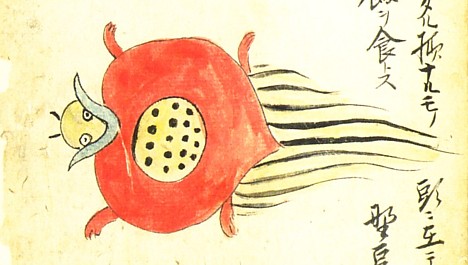
Kameshaku
Kameshaku eats rice and wears an umbrella-like hat that blocks medicine. It can be destroyed by eating wild beans.
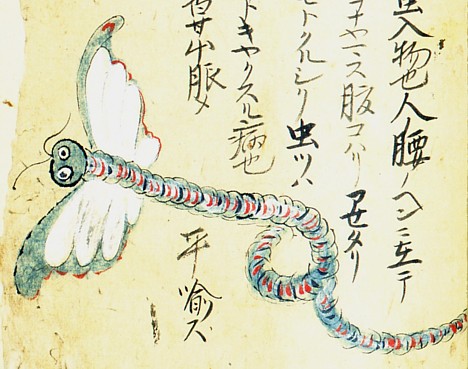
Koshi-no-mushi
Koshi-no-mushi flies into a host's body and makes its way to the lower back area, where it causes diarrhea, sweating and chest pains. The herbs mokko and kanzo (licorice root) are an effective treatment.
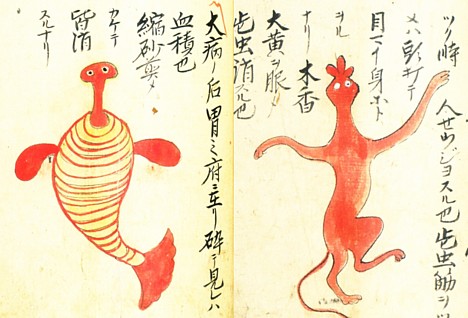
Chishaku, Hizo-no-mushi
Chishaku (Taibyo-no-kesshaku) appears in the stomach after a severe illness. It can be controlled by applying shukusha (wild siamese cardamom).
Hizo-no-mushi is found in the spleen. It causes dizziness and hot flashes when it grabs the host's muscles with its long arms and claws. It can be stopped by ingesting mokko and daio (rhubarb).
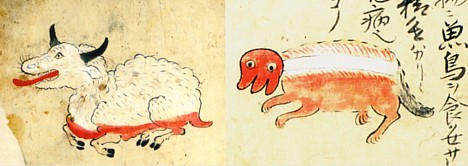
Kiukan and Kishaku
Kiukan (Gyukan) lives in the chest and acts up at meal time. This critter is difficult to get rid of, but acupuncture is an effective treatment.
Kishaku is a dark red beastie that causes its host to develop an unhealthy appetite for oily food. It can be stopped by eating tiger stomach.
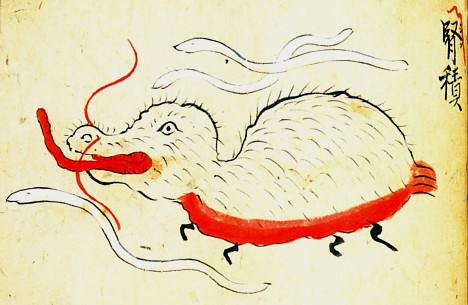
Jinshaku
Jinshaku (Honton) resembles a tiny boar that runs wild through the body. Those infected with Jinshaku develop a weak pulse, a dark complexion, a craving for salty food, and bad breath. Acupuncture is an effective treatment.
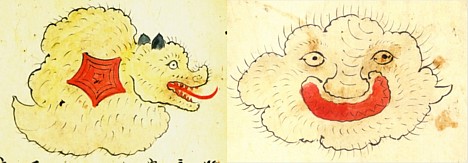
Hishaku, Hinosha
Hishaku is found in the spleen, most often in females. Symptoms include an overpowering appetite for sweets, a yellowish complexion, and a tendency to hum. It can be stopped with acupuncture around the navel.
Hinoshu, also found in the spleen, looks like a rock and remains dormant inside the body until the host visits a crowded sightseeing area, at which time Hinoshu causes dizziness by thrashing about and creating the sensation of rocks crashing against each other. Acupuncture is an effective treatment.
[Source: Kyushu National Museum]

"Toy Box Series, Episode 3: Picture Book 1936" (Omocha-Bako Series, Dai-3-Wa: Ehon 1936) is a 1934 propaganda-ish film about a future (1936) conflict started by a swarm of evil, bat-riding Mickey Mouse clones that descend on a tiny island inhabited by peace-loving dolls and cats (including a Felix lookalike). Overwhelmed by the attack, the desperate island residents bang on the cover of a large picture book to enlist the help of Momotaro, Urashima Taro (the Japanese version of Rip Van Winkle), and other traditional fairy tale heroes and characters. After Urashima Taro uses his famous "mystery box" to turn the big Mickey into a decrepit old fogey, Hanasaka Jiisan makes the cherry trees bloom and the cats and dolls celebrate by dancing to "Tokyo Ondo" (an old Japanese folk song). The soundtrack also includes renditions of the Momotaro song and Gunkan March ("Warship March"), a song that is nowadays typically played at pachinko parlors.
[Via Cartoon Brew via Needcoffee]
In the sophisticated popular culture of the Edo period (1603-1868), much attention was devoted to Japan's rich pantheon of traditional monsters and apparitions, known as yokai. Sometimes frightening, sometimes humorous, these compelling Japanese folk creatures were the subject of numerous artistic and literary works. One such work was Hyakkai Zukan, a collection of picture scrolls completed in 1737 by Sawaki Suushi, a relatively unknown artist who studied under master painter Hanabusa Itcho (1702-1772). Hyakkai Zukan's colorful depictions of Japan's most notorious creatures inspired (and were copied by) yokai artists for generations. Here is a peek inside.
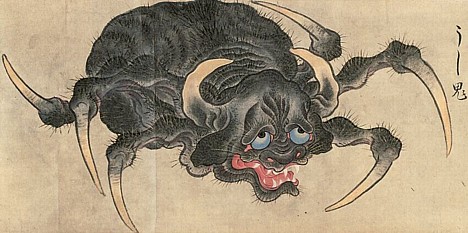
Ushi-oni [Enlarge]
Ushi-oni (lit. "cow devil") is a malevolent sea monster with the head of a bull and the body of a giant spider or crab. It is most often encountered in the coastal waters of western Japan, particularly in Shimane prefecture, where it is feared for its vicious attacks on fishermen. [More]
Ushi-oni is usually seen in connection with a related monster, called Nure-onna.
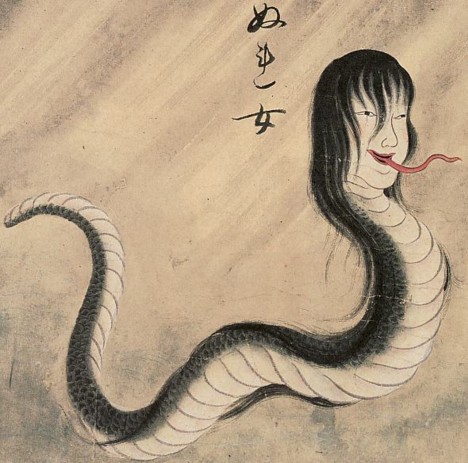
Nure-onna
Nure-onna (lit. "wet woman") is a fast-swimming amphibious creature with the head of a human female and the body of a gigantic snake. Her appearance varies slightly from story to story, but she is usually described as having beady, snake-like eyes and long, sharp claws and fangs. Nure-onna is typically seen at the water's edge, washing her long, flowing hair. In some stories, she carries a small child, which she uses to attract potential victims. When a well-intentioned person offers to hold the baby for Nure-onna, the child attaches itself to the victim's hands and grows heavy, making it nearly impossible to flee. In some stories, Nure-onna uses her long, powerful tongue to suck all the blood from her victim's body. [More]
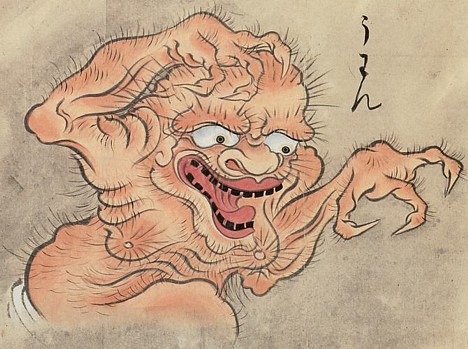
Uwan
In ancient Aomori prefecture legends, Uwan is a disembodied voice that inhabits old, abandoned temples and homes. When a person enters a haunted building, the formless spirit belts out an ear-piercing "Uwan!" (hence the name). The voice is only audible to people inside the building -- those standing outside hear nothing. Uwan consists only of sound and poses no physical danger.
Ancient Japanese legends are rife with examples of formless yokai like Uwan, which consist of nothing but sound, light or other natural phenomena. In the Edo period, however, these yokai assumed physical bodies as artists incorporated them into their work.
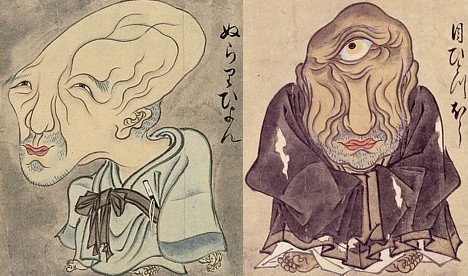
Nurarihyon (left), Mehitotsubou (right)
Another yokai that got a facelift in the Edo period is Nurarihyon, pictured here as as a well-dressed old man with an elongated bald head. Ancient Okayama prefecture legends describe Nurarihyon (lit. "slippery strange") as a marine creature found in the Seto Inland Sea, often seen bobbing around on the surface of the water like some sort of giant jellyfish or octopus. Nurarihyon eludes capture by diving underwater when people approach to investigate.
In the Edo period, Nurarihyon came to be known as a mysterious old man with the uncanny ability to sneak into homes and "take over." When the residents of a home encounter him sitting around drinking tea, they are unable throw him out and cannot help but treat him as the head of the household. Nurarihyon is said to be a highly respected figure in the world of yokai.
Mehitotsubou (above right), a large monk with a cyclopean eye, is a variant of the large shape-shifting monks commonly found in Japanese folk tales.
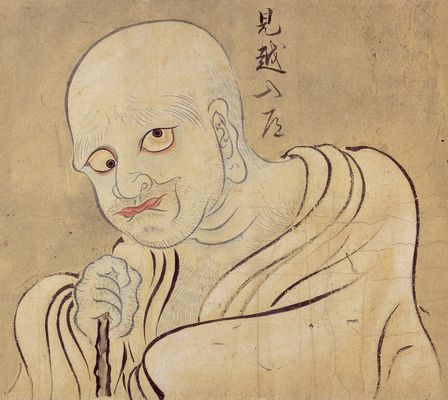
Mikoshi-nyudo
Another monster monk is Mikoshi-nyudo (a.k.a. Miage-nyudo), a large, cross-eyed mendicant encountered on mountain passes or on lonely roads at night. Mikoshi-nyudo grows taller when you look up at him -- and the higher you look, the taller he grows. Look up for too long and you will die, goes the legend, but say "mikoshita" ("I see higher") and he disappears. Mikoshi-nyudo's true identity is unknown, but in some areas he is believed to be a shape-shifting weasel, fox or tanuki.
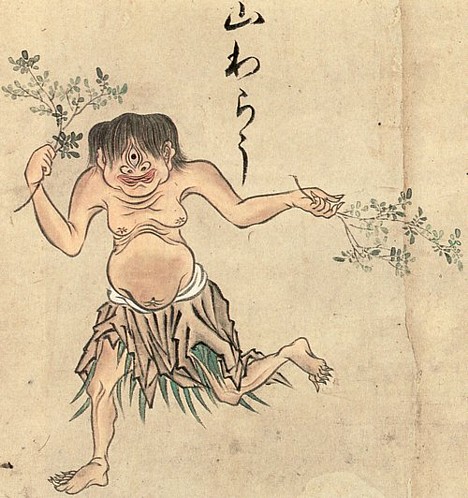
Yama-warau
Yama-warau (a.k.a. Yama-waro) are hairy, one-eyed Garappa (a variety of Kappa found in Kumamoto prefecture) who have gone into the mountains for the winter. These child-sized creatures are known to provide assistance to lumberjacks in the mountains, and they eagerly return again and again to help, as long as they are rewarded with liquor and rice balls.
Like other varieties of Kappa, Yama-warau are fond of playing tricks on people, and they enjoy sumo wrestling. They sometimes break into people's homes to take a bath, and they have a sixth sense for danger, which allows them to escape from people with evil intentions.
At the spring equinox, Yama-warau return to the rivers to live as Garappa. They travel in groups, jumping from one rooftop to the next, all the way down to the water. If, along the way, they come across a new home under construction, they get angry and poke holes in the walls. Legend has it that anyone who goes to the river to catch a glimpse of a returning Yama-warau will become sick.
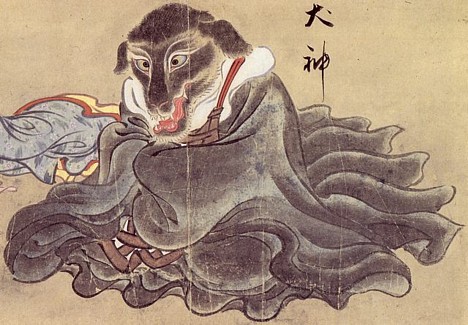
Inugami
An Inugami (lit. "dog god") is a familiar spirit that looks like a dog and acts as a protective guardian. Inugami are extremely powerful and loyal, and they are known to carry out acts of revenge on behalf of their "owners." They can also exist independently, and under some circumstances they may turn against their owners. Inugami also have the ability to possess humans. [More]
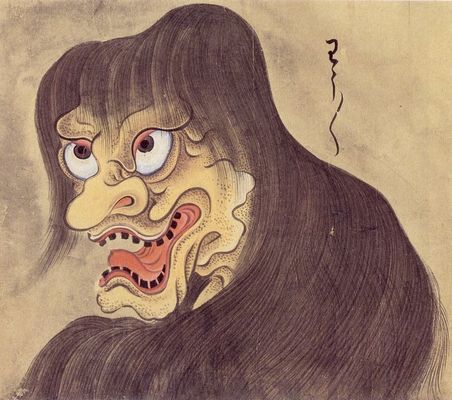
Ouni
Ouni is a mountain hag with a mouth stretching from ear to ear and a thick coat of long, black hair covering her entire body. According to an old Niigata prefecture legend, Ouni appeared one day to a group of women as they were spinning hemp into yarn. After accepting the hairy hag's offer to help, the women watched in surprise as she repeatedly placed raw hemp fiber into her mouth and pulled out finished yarn. After quickly producing a large quantity in this way, Ouni stepped outside and suddenly disappeared. Legend has it that she left footprints in the nearby rocks, which can still be seen to this day.
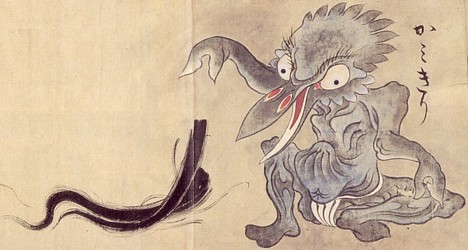
Kami-kiri [Enlarge]
Kami-kiri (lit. "hair-cutter") are ghostly spirits known for sneaking up on people and cutting all their hair off, particularly when they are unknowingly engaged to marry a yokai, spirit or other supernatural creature posing as a human. These hair-cutting attacks are intended to delay or prevent weddings between humans and otherworldly beings, which are typically doomed to failure. [More]
For more images from Hyakkai Zukkan, see the Sawaki Suushi collection at Wikipedia Commons.
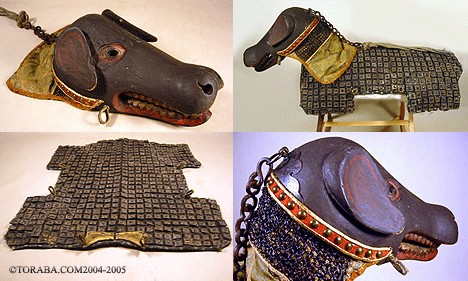
This suit of dog armor -- identified by antique Japanese armor dealer Toraba.Com as the only known and certified authentic example of its kind -- is believed to have been created for the pet of a wealthy, high-ranking and presumably eccentric samurai or daimyo (feudal lord) in the mid to late Edo period (mid-18th to mid-19th century). Although the carved wooden helmet and coat of black-lacquered scale mail would have provided effective protection against enemy attack, evidence suggests the canine never wore the armor into battle. More likely, the suit served as a decorative costume for parades and other formal ceremonial occasions. The samurai dog armor now belongs to an unnamed UK museum.
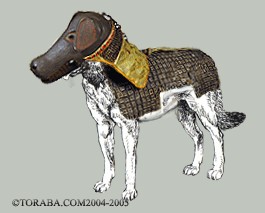
[Link: Toraba.Com (cached page) via Yachigusa Ryu]
With winter in full force, now is the perfect time to explore the frozen wilds of the Japanese web in search of happy fun snowmen.
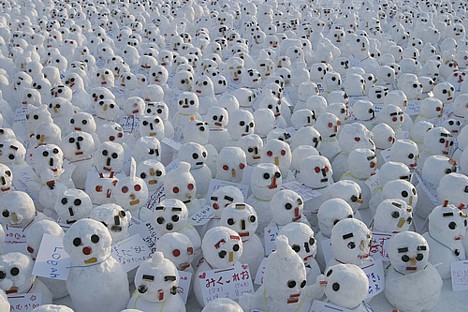
Arguably the best place to see snowmen is the annual Sapporo Snow Festival, one of Japan's most celebrated winter events. This photo (by Flickr user kozyndan) shows a sea of snowmen (yuki-daruma) built by visitors to the festival, who attach written wishes for good luck.
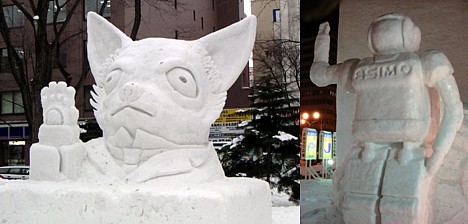
The week-long festival held in early February is home to Japan's largest snow and ice sculpture competition, and all sorts of wacky snow creations can be seen at venues around town -- like this giant chihuahua and Asimo.
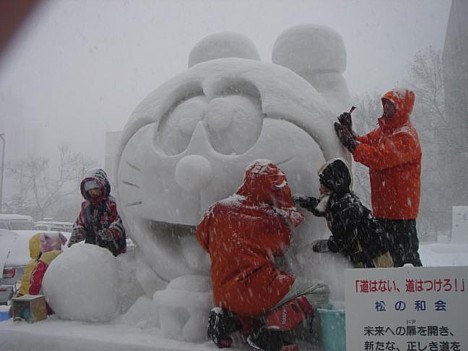
Or your favorite anime character. (Photo from Jonas's Travels in Sapporo website.)
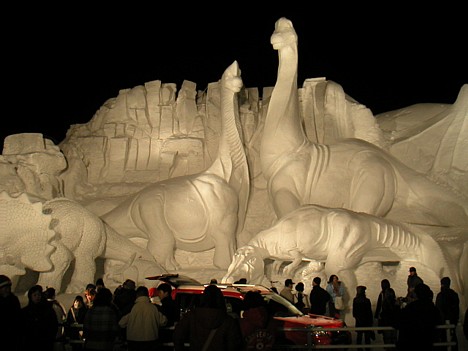
Or much more impressive creations like these dinosaurs. For more pictures from the festival, try a Google image search for "札幌雪祭り" (Sapporo Yuki Matsuri).
Of course, the Sapporo Snow Festival is not the only place to encounter snowmen -- they appear wherever there is snow.
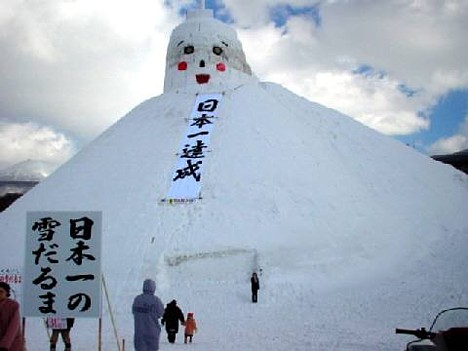
This photo, taken in the town of Kuroishi (Aomori prefecture), shows what is proudly labeled as Japan's largest snowman. The 31-meter-tall (100 ft) monster has a face composed of local agricultural products, such as charred apple trees for the eyebrows, seashells for the eyes, rice for the cheeks, apples for the mouth, daikon radishes for the ears, and carrots for the collar.
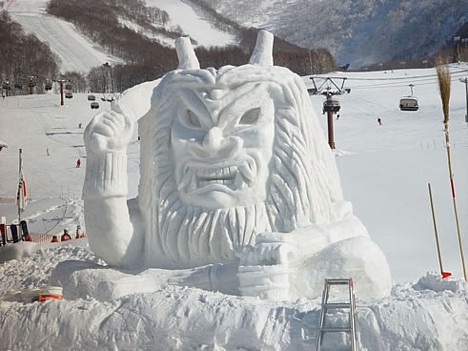
This Namahage folk demon was spotted at last year's Lake Tazawa Snow Festival.
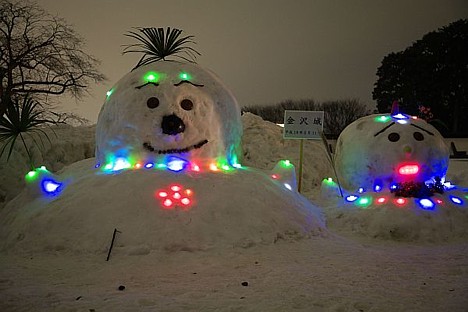
These glowing snowmen were seen standing watch at Kanazawa castle.
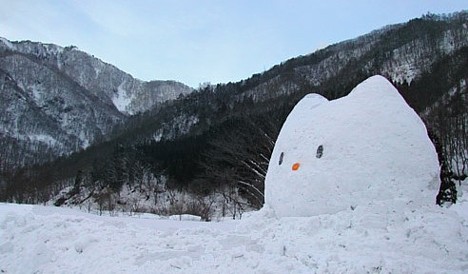
And this one. Haven't we seen this somewhere before?
Sometimes happy snowmen can be found where there is no snow -- like in Tokyo. For this year's Kanda Yuki-Daruma Fair in late January, organizers trucked in 70 tons of snow from rural Gunma prefecture and built 30 large snow creatures on the sidewalks of Kanda.
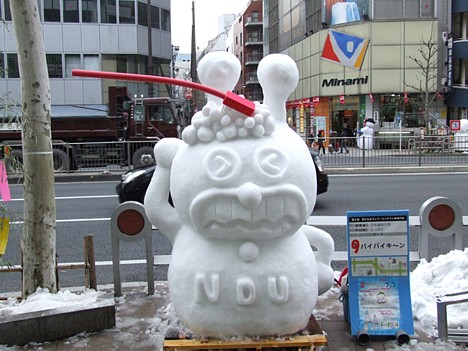
Here is a snowy incarnation of Baikinman, an evil character from the Anpanman anime series. (Photo via Mycom.)
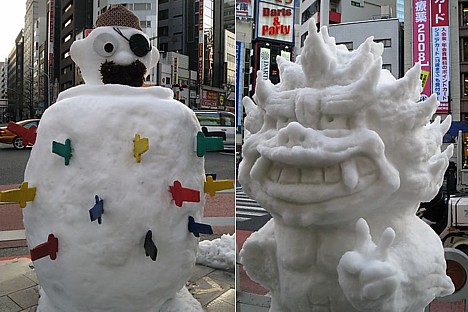
And here are Kurohige Kiki Ippatsu (Pop-up Pirate game) and Shiisaa (a mythical Okinawan creature). For more from the Kanda Yuki-Daruma Fair, see these photos.